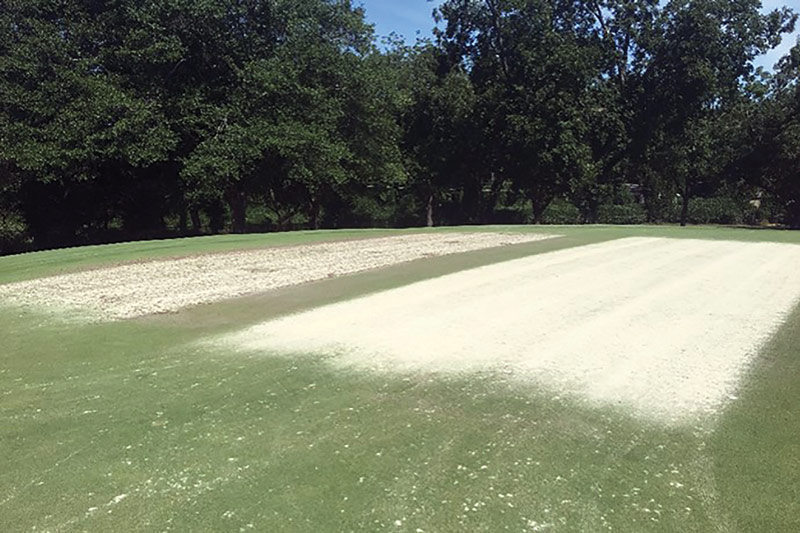
Figure 1. An ultradwarf bermudagrass putting green split in half with the core recycler main block on the left and conventional aerification main block on the right. Photos by G.M. Henry
Ultradwarf bermudagrass (Cynodon dactylon × C. transvaalensis) putting greens often require intensive cultural management that may include frequent verticutting or grooming, topdressing and aerification to maintain optimal playing surfaces (4). Aerification practices are commonly performed on turfgrass systems to alleviate soil compaction and improve drainage and aeration (2, 6).
The most common aerification method, hollow-tine cultivation, involves the physical removal of soil cores, leaving behind open vents that are backfilled with topdressing sand or native soil (2). Significant increases in soil macroporosity for enhanced gas exchange as well as root stimulation for improved nutrient and water uptake outweigh the temporary disruption to the putting surface (3, 5). Using sand topdressing may reduce organic matter content of the soil profile and, therefore, may temporarily decrease soil microbial activity and fertilizer use efficiency.
The core recycler is a self-contained walking machine that sweeps up aerification cores plus topdressing sand and transfers them to four revolving drum screens that separate the organic components (thatch) from bound sand. The recycled sand is returned to the putting surface, while the organic fractions are collected for later disposal. Recycling cores back into the soil profile may reduce total sand topdressing requirements while maintaining organic matter levels, which may increase ultradwarf bermudagrass recovery from core aerification. Furthermore, less nitrogen fertilizer may be necessary for sustaining turfgrass quality and promoting recovery from cultivation.
Materials and methods
Research was conducted on a MiniVerde ultradwarf hybrid bermudagrass putting green established on a sand-based root zone meeting USGA specifications at the University of Georgia golf course (Scott Griffith, superintendent) during the summer of 2017 to compare the influence of conventional aerification practices and the core recycler on plant and soil parameters.
The putting green was split in half, and the main blocks were aerification method (conventional: core aerification + topdressing; core recycler), and the subplots were nitrogen fertilizer treatments (0.5x, 0.75x or 1x rate) arranged within each main block (Figure 1, top).
Editor’s note: Deep vs. shallow tines? A preventive vs. curative approach? A turfgrass consultant advises on which choices are wisest in This or that? Turfgrass aerification decisions.
For cultivation treatment blocks, one side of the putting green was aerified to a depth of 3 inches (7.6 centimeters) with a Toro ProCore 648 hollow-tine aerifier with 0.5-inch (1.3-centimeter) tines set to a 1-by-1-inch (2.5-by-2.5-centimeter) spacing. Cores were removed with a core harvester attached to a utility vehicle. Topdressing sand (USGA specifications) was applied at a rate of 70 cubic feet per 1,000 square feet (237 cubic meters per hectare). Sand was worked into the aerification holes with push brooms in two directions.
The second half of the putting green was also aerified to the same specifications described above (cores not removed) and topdressed at 35 cubic feet per 1,000 square feet (118 cubic meters per hectare; 50% of the conventional topdressing rate). The Wiedenmann core recycler was operated over the surface, and the remaining sand was brushed in with push brooms in two directions (Figure 2, below). Aerification practices were conducted two times during the growing season (Event A: June 9, 2017; Event B: Aug. 2, 2017).
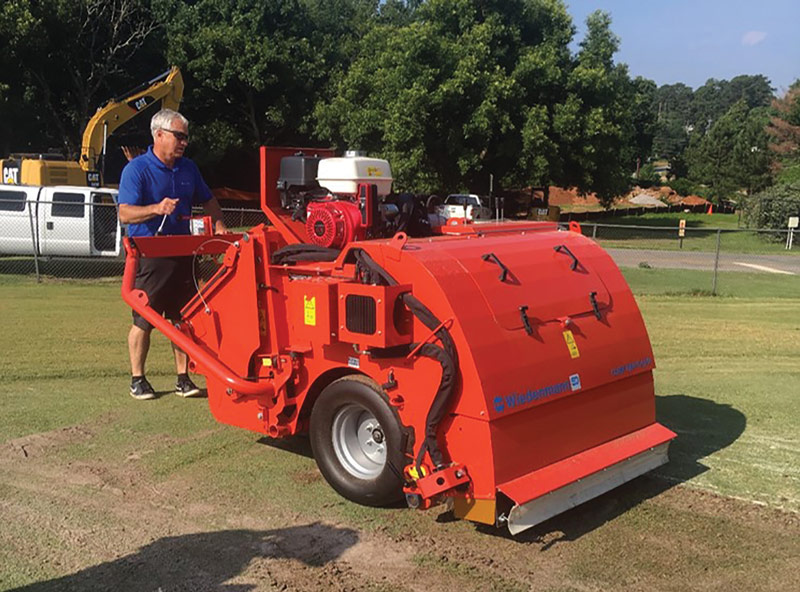
Figure 2. The Wiedenmann core recycler being operated over the putting green surface following core aerification and sand topdressing.
Fertilizer plots (5 feet × 10 feet/1.5 meters × 3 meters) within each cultivation main block received ammonium sulfate (21% nitrogen-0% phosphorous-0% potassium) at 0.15 pounds nitrogen per 1,000 square feet per week (.73 grams nitrogen per square meter; 0.5x rate), 0.23 pounds nitrogen per 1,000 square feet per week (1.12 grams nitrogen per square meter; 0.75x rate), or 0.3 pounds nitrogen per 1,000 square feet per week (1.47 grams nitrogen per square meter; 1x rate). Fertilizer treatments were initiated on June 9, 2017, after the aerification practices had been conducted.
Four soil cores 1 inch (2.5 centimeters) in diameter were removed on June 9, 2017, from each fertility plot to determine initial root biomass. Cores were removed again the day before aerification Event B (Aug. 2, 2017) and at trial termination (Sept. 14, 2017) to calculate the change in root biomass over time. A golf course cup-cutter 4 inches (10.2 centimeters) in diameter was used to remove a single core to a depth of 5 inches (12.7 centimeters) from each fertility plot one day after each aerification event to calculate changes in organic matter content through the loss of ignition test.
Editor’s note: Some biostimulants may reduce thatch without the disruption to play that occurs with aerification or other intensive practices. Read more in Evaluating biological thatch control in turfgrass.
Carbon efflux measurements were recorded with a LI-COR 8100A automated system two to four days after each aerification event to provide an insight into plant root and soil microbial activity (respiration). Turfgrass color and normalized difference vegetation index (NDVI) were recorded weekly until the conclusion of the trial.
Results
Organic matter content
Conventional aerification and the core recycler resulted in similar percentages of organic matter content within soil cores that were removed from the putting green one day after aerification Event A (Table 1, below). However, the aerification methods yielded significant differences in organic matter content following aerification Event B. The fertilizer rates of 0.15 and 0.3 pounds nitrogen per 1,000 square feet per week (the 0.5x and 1.0x rates, respectively) resulted in greater organic matter in response to the core recycler (2.0 and 1.8%, respectively) than to conventional aerification (1.3%). The higher percentage of organic matter observed in response to the core recycler treatments may have been caused by the recycling of aerification cores along with a reduced topdressing rate. More importantly, neither aerification method resulted in a reduction in the percentage of organic matter over time, regardless of the fertilizer treatment.
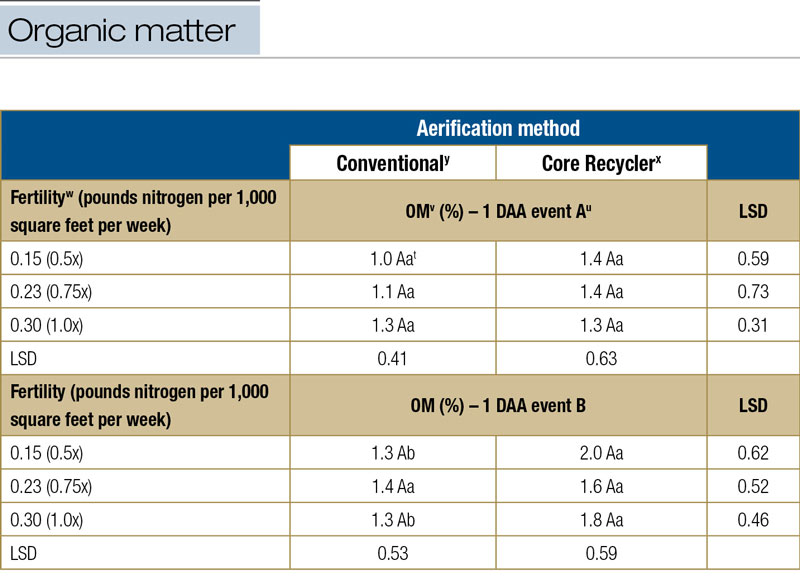
yConventional aerification consisted of core aerification with cores removed followed by topdressing at 70 cubic feet per 1,000 square feet.
xCore recycler aerification consisted of core aerification without cores removed, topdressing at 35 cubic feet per 1,000 square feet followed by use of the core recycler over the putting surface.
wFertility was applied as ammonium sulfate (21N-0P-0K).
vAbbreviations: OM, organic matter; DAA, day after aerification; LSD, least significant difference.
uAerification events A and B were conducted on June 9, 2017, and Aug. 2, 2017, respectively.
tMeans within a column followed by the same uppercase letter are not significantly different. Means within a row followed by the same lowercase letter are not significantly different.
Table 1. Organic matter content calculated through the loss of ignition test (%) of MiniVerde ultradwarf hybrid bermudagrass in response to aerification methods and fertility rates conducted in 2017 in Athens, Ga.
Root and soil respiration
The average carbon efflux measurements following aerification Events A and B were 20.82 and 16.35 micromoles per square meter per second, respectively, regardless of aerification method or fertilizer treatment (Table 2, below). Although no differences were observed between aerification methods or fertilizer treatments following aerification Event A, carbon efflux measurements increased as the fertilizer application rate increased. Higher fertilizer rates may have led to greater root and soil respiration through an increase in plant and microbial activity. This trend was not observed following aerification Event B, nor were differences observed between aerification methods.
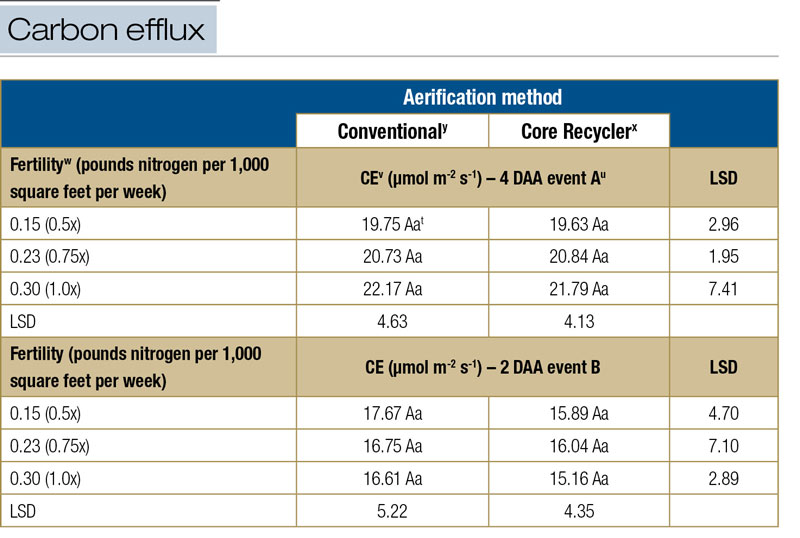
vAbbreviations: CE, carbon efflux; DAA, days after aerification; LSD, least significant difference.
uAerification events A and B were conducted on June 9, 2017, and Aug. 2, 2017, respectively.
tMeans within a column followed by the same uppercase letter are not significantly different. Means within a row followed by the same lowercase letter are not significantly different.
yConventional aerification consisted of core aerification with cores removed followed by topdressing at 70 cubic feet per 1,000 square feet.
xCore recycler aerification consisted of core aerification without cores removed, topdressing at 35 cubic feet per 1,000 square feet followed by use of the core recycler over the putting surface.
wFertility was applied as ammonium sulfate (21N-0P-0K).
Table 2. Carbon efflux measurements (μmol m-2 s-1) — recorded with a LI-COR 8100A automated system two to four days after each aerification event to provide insight into plant and soil microbial activity (respiration) — of MiniVerde ultradwarf hybrid bermudagrass in response to aerification methods and fertility rates conducted in 2017 in Athens, Ga.
Root biomass
There was either no change or a reduction in root biomass in response to conventional aerification, whereas the core recycler resulted in an increase in root biomass, regardless of the fertilizer treatment, compared with the initial biomass measurements (Table 3, below). Differences between aerification methods with respect to change in root biomass were observed in response to the fertilizer treatment of 0.3 pounds nitrogen per 1,000 square feet per week (1.0x rate) one day before aerification Event B (conventional aerification, -0.028 grams; core recycler, 0.050 grams). A similar trend was observed at the conclusion of the study. Greater change in root biomass was observed in response to the core recycler at 0.23 and 0.3 pounds nitrogen per 1,000 square feet per week fertilizer treatments (the 0.75x and 1.0x rates; 0.053 grams and 0.055 grams, respectively) than the conventional aerification treatment at the same fertilizer rates (-0.013 grams and -0.08 grams, respectively).
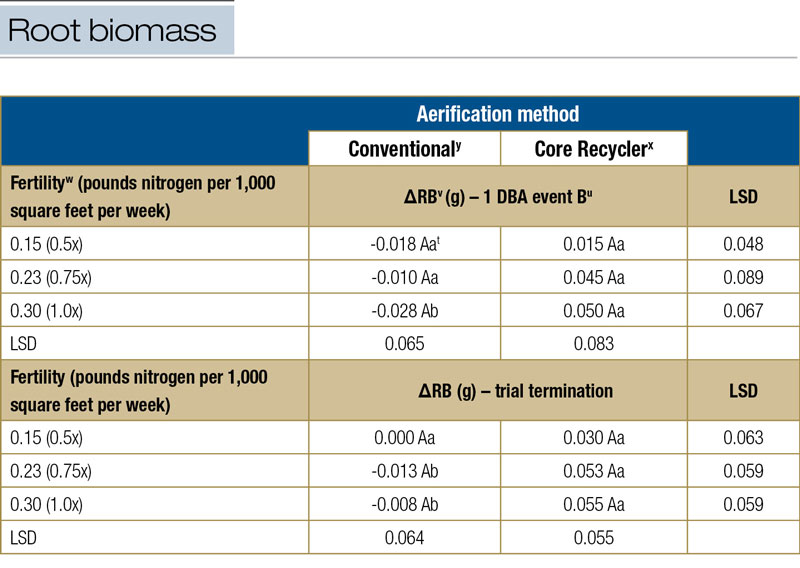
yConventional aerification consisted of core aerification with cores removed followed by topdressing at 70 cubic feet per 1,000 square feet.
xCore recycler aerification consisted of core aerification without cores removed, topdressing at 35 cubic feet per 1,000 square feet followed by use of the core recycler over the putting surface.
wFertility was applied as ammonium sulfate (21N-0P-0K).
vAbbreviations: ΔRB, change in root biomass; DBA, day before aerification; LSD, least significant difference.
uAerification event B was conducted on Aug. 2, 2017, and the trial was terminated on Sept. 14, 2017.
tMeans within a column followed by the same uppercase letter are not significantly different. Means within a row followed by the same lowercase letter are not significantly different.
Table 3. Change in root biomass (g) — determined by comparing four soil cores (1-inch diameter) removed at trial initiation with cores harvested the day before aerification event B and trial termination — of MiniVerde ultradwarf hybrid bermudagrass in response to aerification methods and fertility rates conducted in 2017 in Athens, Ga.
Turfgrass color and NDVI
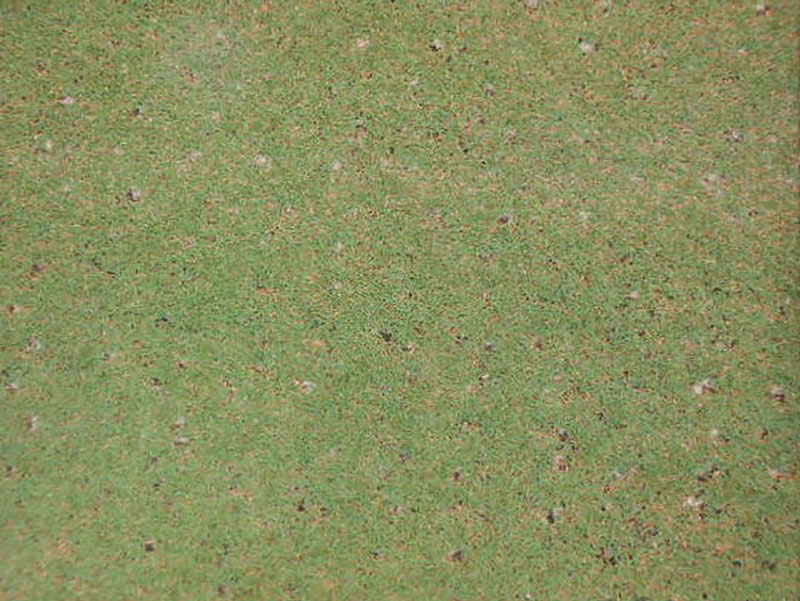
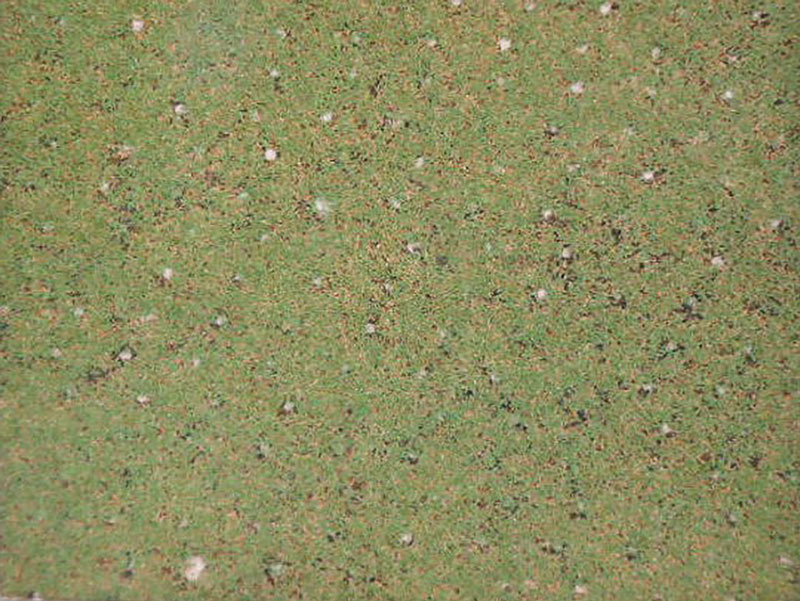
Figure 3. Top: Core recycler plus 0.15 pounds nitrogen per 1,000 square feet per week, one week after aerification Event A. Bottom: Conventional aerification plus 0.30 pounds nitrogen per 1,000 square feet per week, one week after aerification Event A.
Aerification treatment affected turfgrass color. Core recycler practices resulted in greater turfgrass color one week after aerification Event A for each fertilizer rate than conventional aerification (Table 4, below). In fact, turfgrass color at 0.15 pounds nitrogen per 1,000 square feet per week (0.5x rate) in response to the core recycler (turfgrass color of 6.0) was greater than the 0.3 pounds nitrogen per 1,000 square feet per week (1.0x rate) in response to conventional aerification (turfgrass color of 5.6) (Figure 3, above). This corresponded to an increased NDVI for the core recycler treatments compared with conventional aerification, regardless of the fertilizer rate (Table 5, below). At one week after aerification Event B, turfgrass color increased with increasing rates of fertilizer, regardless of the aerification treatment. Core recycler practices resulted in greater turfgrass color one week after aerification Event B for fertilizer applied at 0.15 and 0.3 pounds nitrogen per 1,000 square feet per week (5.9 and 6.5, respectively) than conventional aerification at the same fertilizer rates (5.5 and 6.0, respectively). The greater turfgrass color in response to the core recycler treatments may have been caused by a greater percentage of organic matter retention, which has been documented to increase nutrient content (1).
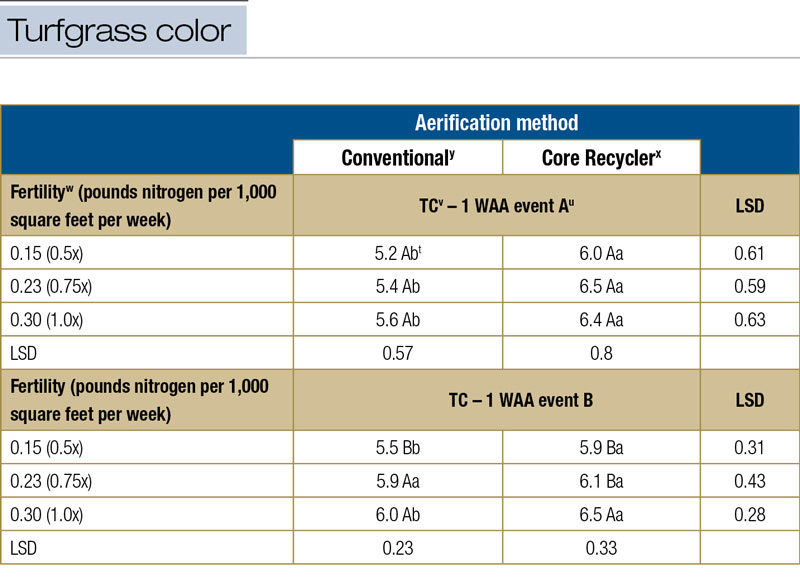
yConventional aerification consisted of core aerification with cores removed followed by topdressing at 70 cubic feet per 1,000 square feet.
xCore recycler aerification consisted of core aerification without cores removed, topdressing at 35 cubic feet per 1,000 square feet followed by use of the core recycler over the putting surface.
wFertility was applied as ammonium sulfate (21N-0P-0K).
vAbbreviations: TC, turfgrass color; WAA, weeks after aerification; LSD, least significant difference.
uAerification events A and B were conducted on June 9, 2017, and Aug. 2, 2017, respectively.
tMeans within a column followed by the same uppercase letter are not significantly different. Means within a row followed by the same lowercase letter are not significantly different.
Table 4. Turfgrass color of Mini Verde ultradwarf hybrid bermudagrass in response to aerification methods and fertility rates conducted in 2017 in Athens, Ga. Visual ratings of turfgrass color were recorded on a scale of 1 to 9, with a rating of 6 considered acceptable.
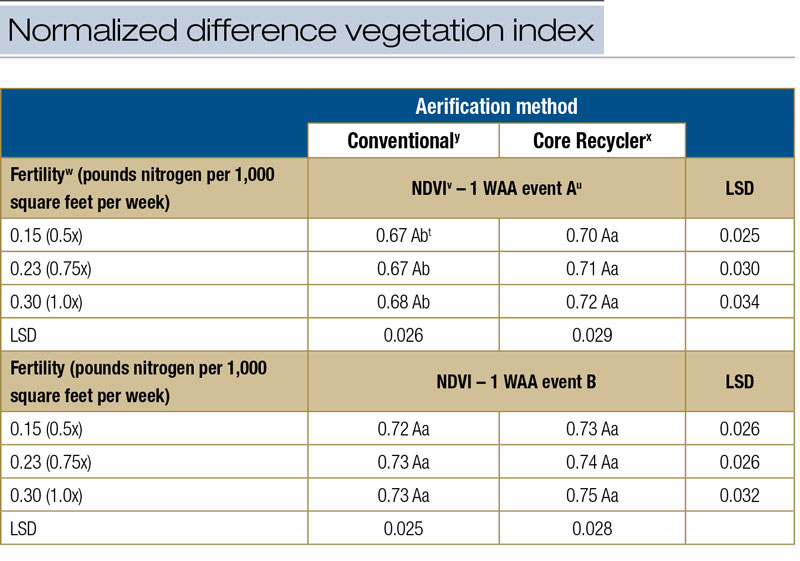
yConventional aerification consisted of core aerification with cores removed followed by topdressing at 70 cubic feet per 1,000 square feet.
xCore recycler aerification consisted of core aerification without cores removed, topdressing at 35 cubic feet per 1,000 square feet followed by use of the core recycler over the putting surface.
wFertility was applied as ammonium sulfate (21N-0P-0K).
vAbbreviations: NDVI, normalized difference vegetative index; WAA, weeks after aerification; LSD, least significant difference.
uAerification events A and B were conducted on June 9, 2017, and Aug. 2, 2017, respectively.
tMeans within a column followed by the same uppercase letter are not significantly different. Means within a row followed by the same lowercase letter are not significantly different
Table 5. Normalized difference vegetation index (NDVI) of MiniVerde ultradwarf hybrid bermudagrass in response to aerification methods and fertility rates conducted in 2017 in Athens, Ga. NDVI was recorded with a chlorophyll meter on a scale of 0 to 1, where 1 is best. An average of three readings was obtained per plot.
Conclusions
Use of the core recycler resulted in a greater percentage of organic matter (only after aerification Event B) and change in root biomass than the conventional core aerification practices. This may have contributed to the higher turfgrass color and NDVI ratings seen for the core recycler treatments. However, this phenomenon only lasted for two weeks after each aerification event. Traditionally, organic matter in an ultradwarf bermudagrass putting green meeting USGA specifications is reduced or held constant to decrease the potential for hydrophobic soil conditions that may slow water infiltration and diminish putting green firmness. Alternating the use of the core recycler with other cultivation techniques may be necessary to manage organic matter in the soil profile.
The research says ...
- In some circumstances, use of the core recycler resulted in a greater percentage of organic matter in the soil profile.
- Alternating the use of the core recycler with other cultivation techniques may be necessary to manage organic matter in the soil profile.
- Neither aerification method resulted in a reduction in the percentage of organic matter over time, regardless of the fertilizer treatment.
Literature cited
- Doran, J.W., and M.S. Smith. 1987. Organic matter management and utilization of soil and fertilizer nutrients. In: Follett et al. (Eds.), Soil Fertility and Organic Matter as Critical Components of Production Systems, American Society of Agronomy, Madison, Wis. 19:53-72 (https://doi.org/10.2136/sssaspecpub19.c4).
- Emmons, R.D. 2007. Turfgrass science and management. Fourth edition. Delmar Cengage Learning, Clifton Park, N.Y.
- Fry, J., and B. Huang. 2004. Applied turfgrass science and physiology. John Wiley & Sons, Hoboken, N.J.
- McCarty, L.B. 2004. Best golf course management practices. Third edition. Prentice Hall, Upper Saddle River, N.J.
- Sills, M.J., and R.N. Carrow. 1983. Turfgrass growth, N use, and water use under soil compaction and N fertilization. Agronomy Journal 75(3):488-492 (https://doi.org/10.2134/agronj1983.00021962007500030017x).
- Wiecko, G., R.N. Carrow and K.J. Karnok. 1993. Turfgrass cultivation methods: Influence on soil physical, root/shoot, and water relationships. International Turfgrass Society Research Journal 7:451-457.
G.M. Henry, Ph.D., is the Athletic Association Endowed Professor of Environmental Turfgrass Science; W.J. Bowling, M.S., is a former graduate student; and K.A. Tucker, M.S., is a research assistant at the University of Georgia, Athens, Ga. Bowling is now employed at the Omni PGA Frisco Resort.